
Gamla stan
Encyclopedia
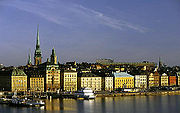
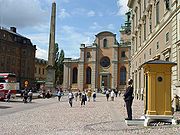
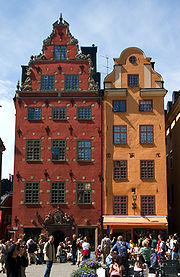
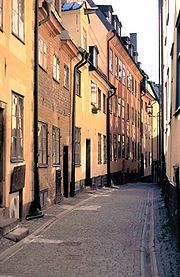

Stockholm
Stockholm is the capital and the largest city of Sweden and constitutes the most populated urban area in Scandinavia. Stockholm is the most populous city in Sweden, with a population of 851,155 in the municipality , 1.37 million in the urban area , and around 2.1 million in the metropolitan area...
, Sweden
Sweden
Sweden , officially the Kingdom of Sweden , is a Nordic country on the Scandinavian Peninsula in Northern Europe. Sweden borders with Norway and Finland and is connected to Denmark by a bridge-tunnel across the Öresund....
. Gamla stan consists primarily of the island Stadsholmen
Stadsholmen
Stadsholmen is the historical name of an island in the centre of Stockholm, Sweden. Together with the small islands Riddarholmen and Helgeandsholmen it forms the Old town of Stockholm....
. The surrounding islets Riddarholmen
Riddarholmen
Riddarholmen is a small islet in central Stockholm, Sweden. The island forms part of Gamla Stan, the old town, and houses a number of private palaces dating from the 17th century...
, Helgeandsholmen
Helgeandsholmen
Helgeandsholmen is a small island in central Stockholm, Sweden. It is located north of Stadsholmen, and east of Strömsborg, with which, together with Riddarholmen, it forms Gamla stan, the old town of Stockholm...
, and Strömsborg
Strömsborg
Strömsborg is a small islet in central Stockholm, Sweden, located north of Stadsholmen, and west of Helgeandsholmen, between the bridges Centralbron, a motorway passing through central Stockholm, and Vasabron...
are officially part of, but not colloquially included in, Gamla stan. The word "stan" is simply a contraction of the word "staden" ("sta'n"), meaning "the town."
Overview
The town dates back to the 13th century, and consists of medieval alleyways, cobbledCobblestone
Cobblestones are stones that were frequently used in the pavement of early streets. "Cobblestone" is derived from the very old English word "cob", which had a wide range of meanings, one of which was "rounded lump" with overtones of large size...
streets, and archaic architecture. North German architecture
Brick Gothic
Brick Gothic is a specific style of Gothic architecture common in Northern Europe, especially in Northern Germany and the regions around the Baltic Sea that do not have natural rock resources. The buildings are essentially built from bricks...
has had a strong influence in the Old Town's construction.
Stortorget
Stortorget (Stockholm)
Stortorget is a small public square in Gamla Stan, the old town in central Stockholm, Sweden. It is the oldest square in Stockholm, the historical centre around which the medieval urban conglomeration gradually came into being...
is the name of the scenic large square in the centre of Gamla Stan, which is surrounded by old merchants' houses including the Stockholm Stock Exchange Building
Stockholm Stock Exchange Building
The Stock Exchange Building is a building originally erected for, and is still owned by, the Swedish Academy, located on the north side of the square Stortorget in Gamla stan, the old town in central Stockholm, Sweden....
. The square was the site of the Stockholm Bloodbath
Stockholm Bloodbath
The Stockholm Bloodbath, or the Stockholm Massacre , took place as the result of a successful invasion of Sweden by Danish forces under the command of King Christian II...
, where Swedish noblemen
Nobility
Nobility is a social class which possesses more acknowledged privileges or eminence than members of most other classes in a society, membership therein typically being hereditary. The privileges associated with nobility may constitute substantial advantages over or relative to non-nobles, or may be...
were massacred by the Danish King Christian II
Christian II of Denmark
Christian II was King of Denmark, Norway and Sweden , during the Kalmar Union.-Background:...
in November, 1520. The following revolt and civil war led to the dissolution of the Kalmar Union
Kalmar Union
The Kalmar Union is a historiographical term meaning a series of personal unions that united the three kingdoms of Denmark, Norway , and Sweden under a single monarch, though intermittently and with a population...
and the subsequent election of King Gustav I
Gustav I of Sweden
Gustav I of Sweden, born Gustav Eriksson of the Vasa noble family and later known simply as Gustav Vasa , was King of Sweden from 1523 until his death....
.
As well as being home to the Stockholm Cathedral
Storkyrkan
Sankt Nikolai kyrka , most commonly known as Storkyrkan and Stockholms domkyrka , is the oldest church in Gamla Stan, the old town in central Stockholm, Sweden. It is an important example of Swedish Brick Gothic...
, the Nobel Museum
Nobel Prize
The Nobel Prizes are annual international awards bestowed by Scandinavian committees in recognition of cultural and scientific advances. The will of the Swedish chemist Alfred Nobel, the inventor of dynamite, established the prizes in 1895...
, and the Riddarholm church
Riddarholmskyrkan
The Riddarholmen Church is the burial church of the Swedish monarchs. It is located on the island of Riddarholmen, close to the Royal Palace in Stockholm, Sweden. The congregation was dissolved in 1807 and today the church is used only for burial and commemorative purposes. Swedish monarchs from...
, Gamla stan also boasts Kungliga slottet, Sweden's baroque Royal Palace
Stockholm Palace
The Stockholm Palace is the official residence and major royal palace of the Swedish monarch. . Stockholm Palace is located on Stadsholmen , in Gamla Stan in the capital, Stockholm...
, built in the 18th century after the previous palace Tre Kronor
Tre kronor (castle)
Tre Kronor or Three Crowns was a castle located in Stockholm, Sweden, on the site where Stockholm Palace is today. It is believed to have been a citadel that Birger Jarl built into a royal castle in the middle of the 13th century...
burned down. The House of Nobility (Riddarhuset) is on the north-western corner of Gamla stan.
The restaurant Den gyldene freden
Den Gyldene Freden
Den gyldene freden is a restaurant in the old town of Stockholm, Sweden. It's one of Sweden's most well-known restaurants and the oldest restaurant in the world to have the same surroundings, which is noticed in the Guinness book of records...
is located on Österlånggatan
Österlånggatan
Österlånggatan is a street in Gamla stan, the old town of Stockholm, Sweden. Stretching southward from Slottsbacken to Järntorget, it forms a parallel street to Baggensgatan and Skeppsbron...
. It has been in business since 1722 and according to the Guinness Book of Records is the oldest existing restaurant with an unaltered interior. A statue of St. George and the Dragon (sculpted by Bernt Notke
Bernt Notke
' was the most important German painter and sculptor in Northern Europe in his times....
) can be found in the Stockholm Cathedral
Storkyrkan
Sankt Nikolai kyrka , most commonly known as Storkyrkan and Stockholms domkyrka , is the oldest church in Gamla Stan, the old town in central Stockholm, Sweden. It is an important example of Swedish Brick Gothic...
, while Riddarholmskyrkan
Riddarholmskyrkan
The Riddarholmen Church is the burial church of the Swedish monarchs. It is located on the island of Riddarholmen, close to the Royal Palace in Stockholm, Sweden. The congregation was dissolved in 1807 and today the church is used only for burial and commemorative purposes. Swedish monarchs from...
is the royal burial church. Bollhustäppan
Bollhustäppan
Bollhustäppan is a small public space in Gamla stan Is the old town in central Stockholm, Sweden. Named after Bollhuset, a historical theatre, it is located south of Slottsbacken just behind the Finnish Church, while two gates connects it to Trädgårdsgatan....
, a small courtyard at Slottsbacken
Slottsbacken
Slottsbacken is a street in Gamla stan, the old town in central Stockholm, Sweden.It stretches east from the Stockholm Cathedral and the Royal Palace down to the street Skeppsbron which passes along the eastern waterfront of the old town...
behind Finska kyrkan, just south of the main approach to the Royal Palace, is home to one of the smallest statues in Sweden, a little boy in wrought iron. The plaque just below the statue says its name "Järnpojken" ("The Iron Boy"). It was created by Liss Eriksson
Liss Eriksson
Liss Eriksson was a Swedish sculptor.- Life :The son of the sculptor Christian Eriksson , Liss Eriksson grew up on Maria Prästgårdsgatan on Södermalm in southern-central Stockholm...
in 1919.
From the mid 19th to the mid 20th century Gamla stan was considered a slum
Slum
A slum, as defined by United Nations agency UN-HABITAT, is a run-down area of a city characterized by substandard housing and squalor and lacking in tenure security. According to the United Nations, the percentage of urban dwellers living in slums decreased from 47 percent to 37 percent in the...
, many of its historical buildings left in disrepair, and just after WW2, several blocks together five alleys were demolished for the enlargement of the Parliament
Parliament of Sweden
The Riksdag is the national legislative assembly of Sweden. The riksdag is a unicameral assembly with 349 members , who are elected on a proportional basis to serve fixed terms of four years...
(see Brantingtorget
Brantingtorget
Brantingtorget is the courtyard of the so called Kanslihusannexet , acting as one of the public squares in Gamla stan, the old town in central Stockholm, Sweden....
). From the 1980s, however, it has become a tourist attraction as the charm of its medieval
Medieval architecture
Medieval architecture is a term used to represent various forms of architecture common in Medieval Europe.-Characteristics:-Religious architecture:...
, Renaissance
Renaissance
The Renaissance was a cultural movement that spanned roughly the 14th to the 17th century, beginning in Italy in the Late Middle Ages and later spreading to the rest of Europe. The term is also used more loosely to refer to the historical era, but since the changes of the Renaissance were not...
architecture and later additions have been valued by later generations.
While the archaeology of the 370 properties in Gamla stan remains poorly documented, recent inventories done by volunteers have shown many buildings previously dated to the 17thy and 18th centuries, can be up to 300 years older. There is also a metro
Stockholm Metro
The Stockholm Metro is a metro system in Stockholm, Sweden. The first line opened in 1950, and today the system has 100 stations in use, of which 47 are underground and 53 above ground. There are seven lines numbered from 10 to 19, in three groups identified by a color: the Green, Red and Blue lines...
station in Gamla Stan with the same name.
Origin of the name
Until the mid 19th century Gamla stan was simply referred to as själva staden ("the city itself"), which must have made sense since the areas surrounding it was still mostly rural in character and referred to as malmarna ("the ridges"). On maps and in literature from the mid 19th century it started to be called staden mellan broarna ("the city between the bridges") or staden inom broarna ("the city within the bridges"), a name which remained official until 1980, and from 1934 also included the islets HelgeandsholmenHelgeandsholmen
Helgeandsholmen is a small island in central Stockholm, Sweden. It is located north of Stadsholmen, and east of Strömsborg, with which, together with Riddarholmen, it forms Gamla stan, the old town of Stockholm...
and Strömsborg
Strömsborg
Strömsborg is a small islet in central Stockholm, Sweden, located north of Stadsholmen, and west of Helgeandsholmen, between the bridges Centralbron, a motorway passing through central Stockholm, and Vasabron...
. The name Gamla stan probably dates back to the early 20th century, then used colloquially. In 1957 a station of the Stockholm metro
Stockholm Metro
The Stockholm Metro is a metro system in Stockholm, Sweden. The first line opened in 1950, and today the system has 100 stations in use, of which 47 are underground and 53 above ground. There are seven lines numbered from 10 to 19, in three groups identified by a color: the Green, Red and Blue lines...
was opened here with the name Gamla stan. Even though the official name was changed to Gamla stan in 1980, modern Stockholm is occasionally called "The city between the bridges".
Prehistory
Stockholm derives its mythological origin from a dwelling place called Agnefit. As the second element fit means 'moist meadowMeadow
A meadow is a field vegetated primarily by grass and other non-woody plants . The term is from Old English mædwe. In agriculture a meadow is grassland which is not grazed by domestic livestock but rather allowed to grow unchecked in order to make hay...
', this place was supposedly located on the western shore of today's Stadsholmen
Stadsholmen
Stadsholmen is the historical name of an island in the centre of Stockholm, Sweden. Together with the small islands Riddarholmen and Helgeandsholmen it forms the Old town of Stockholm....
(arguably the only possible location for a meadow at the time). The first element of this name is, explains the historian Snorri Sturluson
Snorri Sturluson
Snorri Sturluson was an Icelandic historian, poet, and politician. He was twice elected lawspeaker at the Icelandic parliament, the Althing...
(1178–1241), derived from King Agne
Agne
Agne, English: Agni, Hogne or Agni Skjálfarbondi was a mythological king of Sweden, of the House of Yngling.Snorri Sturluson relates that he was the son of Dag the Wise, and he was mighty and famous. He was also skilled in many ways....
, a presumably mythological king who, in a dim and distant past (around 400 A.D. according to some historians), encamped here after having successfully raided Finland
Finland
Finland , officially the Republic of Finland, is a Nordic country situated in the Fennoscandian region of Northern Europe. It is bordered by Sweden in the west, Norway in the north and Russia in the east, while Estonia lies to its south across the Gulf of Finland.Around 5.4 million people reside...
. His intentions were to marry Skjalf, the daughter of the defeated Finnish chieftain. The young woman, however, tricked him to arrange a celebration including prominent guests which eventually turned into a boozing party, and, while Agne slept sober, Skjalf had him hung in his gold necklace before escaping.
While the reliability of this story remains disputed, dendrochronological
Dendrochronology
Dendrochronology or tree-ring dating is the scientific method of dating based on the analysis of patterns of tree-rings. Dendrochronology can date the time at which tree rings were formed, in many types of wood, to the exact calendar year...
examinations of logs found on Helgeandsholmen
Helgeandsholmen
Helgeandsholmen is a small island in central Stockholm, Sweden. It is located north of Stadsholmen, and east of Strömsborg, with which, together with Riddarholmen, it forms Gamla stan, the old town of Stockholm...
just north of Stadsholmen in 1978-1980, concluded these trees were cut down during the period 970-1020, most of them from the later part of that period, and these logs presumably gave the entire city its present name, Stock-holm, "Log-Islet".
Middle Ages and Vasa era
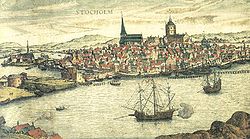
Västerlånggatan
Västerlånggatan is a street in Gamla stan, the old town of Stockholm, Sweden. Stretching southward between the squares Mynttorget and Järntorget, it follows the course of the city's now demolished 13th century defensive wall....
and Österlånggatan
Österlånggatan
Österlånggatan is a street in Gamla stan, the old town of Stockholm, Sweden. Stretching southward from Slottsbacken to Järntorget, it forms a parallel street to Baggensgatan and Skeppsbron...
(i.e. "Western/Eastern Long Street") — which passed between the shorelines of the era and the eastern and western city walls. The eastern wall passed between two defensive towers; the northern being that of what was to become the castle Three Crowns
Tre kronor (castle)
Tre Kronor or Three Crowns was a castle located in Stockholm, Sweden, on the site where Stockholm Palace is today. It is believed to have been a citadel that Birger Jarl built into a royal castle in the middle of the 13th century...
, destroyed by fire in 1697, and the southern, of which no archaeological traces have been found, is known to have been given to the Blackfriars by King Magnus Eriksson
Magnus IV of Sweden
Magnus Eriksson as Magnus IV was king of Sweden , including Finland, as Magnus VII King of Norway , including Iceland and Greenland, and also ruled Scania . He has also vindictively been called Magnus Smek...
(1316–1377) in 1336 and therefore was arguably located at the location for the monastery, in the southern end of Prästgatan
Prästgatan
Prästgatan is a street in Gamla stan, the old town in central Stockholm, Sweden, stretching from a cul-de-sac west of the Royal Palace to the street Österlånggatan in the southern corner of the old town. Prästgatan forms a parallel street to Västerlånggatan, Trångsund, Skomakargatan, and...
, north of the square Järntorget
Järntorget (Stockholm)
Järntorget is a small public square in Gamla stan, the old town in central Stockholm, Sweden. Located in the southernmost corner of the old town, the square connects the thoroughfares Västerlånggatan and Österlånggatan, while the two alleys, Södra Bankogränd and Norra Bankogränd, stretches east...
. The steep precipices forming the outskirts of the original city is still discernible in the pronounced difference of levels in today's urban landscape: The two long streets which ran just outside the city walls — Västerlånggatan and Prästgatan
Prästgatan
Prästgatan is a street in Gamla stan, the old town in central Stockholm, Sweden, stretching from a cul-de-sac west of the Royal Palace to the street Österlånggatan in the southern corner of the old town. Prästgatan forms a parallel street to Västerlånggatan, Trångsund, Skomakargatan, and...
(some 5 metres) — and the streets running parallel to them, just inside the city walls — Österlånggatan and Bollhusgränd
Bollhusgränd
Bollhusgränd is an alley in Gamla stan, the old town in central Stockholm, Sweden. Named after Bollhuset, a historical theatre, it connects Slottsbacken to Köpmantorget, and as Baggensgatan extends the alley further south beyond Köpmangatan, together they form a parallel street to Österlånggatan...
-Baggensgatan
Baggensgatan
Baggensgatan is a street in Gamla stan, the old town in central Stockholm, Sweden. Forming a southern extension to the street Bollhusgränd near the square Köpmantorget, it stretches to the southern end of Svartmangatan...
(up to 10 metres).
The center of the medieval city was probably just a fairground south of the town hall and the only church in the village. The market place, originally smaller than the present and enlarged following a fire in the early 15th century, was eventually surrounded by permanent buildings and evolved into the present public square Stortorget ("The Large Square"), still located south of the so called Stock Exchange
Stockholm Stock Exchange Building
The Stock Exchange Building is a building originally erected for, and is still owned by, the Swedish Academy, located on the north side of the square Stortorget in Gamla stan, the old town in central Stockholm, Sweden....
and the Cathedral
Storkyrkan
Sankt Nikolai kyrka , most commonly known as Storkyrkan and Stockholms domkyrka , is the oldest church in Gamla Stan, the old town in central Stockholm, Sweden. It is an important example of Swedish Brick Gothic...
. While Stockholm is likely to have expanded quickly, it remains much debated if the expansion was planned in accordance to the model of southern prototypes (e.g. such as Lübeck
Lübeck
The Hanseatic City of Lübeck is the second-largest city in Schleswig-Holstein, in northern Germany, and one of the major ports of Germany. It was for several centuries the "capital" of the Hanseatic League and, because of its Brick Gothic architectural heritage, is listed by UNESCO as a World...
) and, as historical sources traditionally have rendered it, governed directly by Birger Jarl
Birger jarl
, or Birger Magnusson, was a Swedish statesman, Jarl of Sweden and a member of the House of Bjelbo, who played a pivotal role in the consolidation of Sweden. Birger also led the Second Swedish Crusade, which established Swedish rule in Finland. Additionally, he is traditionally attributed to have...
(1210–1266) and Magnus Ladulås
Magnus III of Sweden
Magnus III Ladulås of Sweden, Swedish: Magnus Birgersson or Magnus Ladulås was King of Sweden from 1275 until his death in 1290....
(1240–1290), or, as some historian have argued, a somewhat desultory if not entirely unmethodical process. Nervertheless, the medieval thoroughfares led from the large square in all four cardinal direction
Cardinal direction
The four cardinal directions or cardinal points are the directions of north, east, south, and west, commonly denoted by their initials: N, E, S, W. East and west are at right angles to north and south, with east being in the direction of rotation and west being directly opposite. Intermediate...
s: Köpmangatan
Köpmangatan
Köpmangatan is a street in Gamla stan, the old town of Stockholm, Sweden. A parallel street to Trädgårdsgatan, it is stretching from the central square Stortorget to Köpmantorget, intercepted by Trädgårdstvärgränd, Skeppar Olofs Gränd, Peder Fredags Gränd, Själagårdsgatan, Staffan Sasses Gränd,...
("Merchant's Street") led east down to a second square by the water, Fisketorget
Fisketorget
Fisketorget or Fiskaretorget is a historical public square in Gamla stan, the old town in central Stockholm, Sweden...
("Fishery Square"). Svartmangatan ("Black Man's Street", named after the Blackfriars monastery) and Skomakargatan
Skomakargatan
Skomakargatan is a street in Gamla stan, the old town of Stockholm, Sweden, Stretching between the square Stortorget and the streets Kindstugatan and Tyska Brinken, it forms a parallel street to Prästgatan and Svartmangatan....
("Shoemaker's Street") led south to the financial centre of the city. Located where is today Järntorget
Järntorget (Stockholm)
Järntorget is a small public square in Gamla stan, the old town in central Stockholm, Sweden. Located in the southernmost corner of the old town, the square connects the thoroughfares Västerlånggatan and Österlånggatan, while the two alleys, Södra Bankogränd and Norra Bankogränd, stretches east...
("The Iron Square"), this marketplace was at the time not much more than two landing stages separated by an open space on the southern corner of the island. On either side of this marketplace, considerably larger than the present square, was on its eastern side Koggabron (named after, cogs
Cog (ship)
A cog is a type of ship that first appeared in the 10th century, and was widely used from around the 12th century on. Cogs were generally built of oak, which was an abundant timber in the Baltic region of Prussia. This vessel was fitted with a single mast and a square-rigged single sail...
, a type of medieval merchant vessel) and today superseded by Skeppsbron
Skeppsbron
Skeppsbron is both a street and a quay in Gamla stan, the old town of Stockholm, capital of Sweden, stretching from the bridge Strömbron in front of the Royal Palace southward to Slussen....
, and on its western side was Kornhamn ("Corn Harbour") receiving the ships from Lake Mälaren
Mälaren
Lake Mälaren is the third-largest lake in Sweden, after Lakes Vänern and Vättern. Its area is 1,140 km² and its greatest depth is 64 m. Mälaren spans 120 kilometers from east to west...
, located near today's Kornhamnstorg
Kornhamnstorg
Kornhamnstorg is a public square in Gamla stan, the old town in central Stockholm, Sweden.Old names : Kornhaffn , Jernboen , Åkaretorget , Kornhampns torget...
. Trångsund
Trångsund
Trångsund is a part of Huddinge to the south of Stockholm located between the two lakes Magelungen and Drevviken. The region Trångsund/Skogås has about 21 500 inhabitants. From Trångsund it is a 20 minute travel to Stockholm central by train.-Sports:...
("Narrow Strait"), at the time much narrower than today, was leading north past the cathedral.
As the city gate
City gate
A city gate is a gate which is, or was, set within a city wall. Other terms include port.-Uses:City gates were traditionally built to provide a point of controlled access to and departure from a walled city for people, vehicles, goods and animals...
s were patently the weakest point in all medieval fortifications, the fewer the better was the obvious rule. In medieval Stockholm, presumably three or four narrow gates opened the wall: Through the eastern wall a single gate allowed Köpmangatan to pass down to the shore, while the others, all leading to Västerlånggatan, were located where today are Storkyrkobrinken
Storkyrkobrinken
Storkyrkobrinken is a street in Gamla stan, the old town in central Stockholm, Sweden.Leading from Högvaktsterrassen near the Royal Palace down to Myntgatan and Riddarhustorget it forms a parallel street to Salviigränd and Stora Gråmunkegränd and is crossed by Trångsund, Prästgatan, and...
("Slope of the Great Church"), Kåkbrinken
Kåkbrinken
Kåkbrinken is a street in Gamla stan, the old town of Stockholm, Sweden. Stretching from the western waterfront Munkbroleden to the central square Stortorget, it forms a parallel street to Yxsmedsgränd, Solgränd, and Bedoirsgränd, while being crossed by Munkbrogatan, Lilla Nygatan, Stora Nygatan,...
("Slope of the [Ramshackle] House"), and Tyska Brinken
Tyska Brinken
Tyska Brinken is a street in Gamla stan, the old town in central Stockholm, Sweden. Extending Kindstugatan passed the German Church down to the square Mälartorget, it is crossed by Skomakargatan, Prästgatan, Västerlånggatan, Stora Nygatan, Lilla Nygatan, and Munkbrogatan, while forming a parallel...
("German Slope"). Surrounding the Royal Palace
Stockholm Palace
The Stockholm Palace is the official residence and major royal palace of the Swedish monarch. . Stockholm Palace is located on Stadsholmen , in Gamla Stan in the capital, Stockholm...
was an open area called Sanden ("The Sand"), intentionally kept free for defensive reasons and including the present location of Slottsbacken
Slottsbacken
Slottsbacken is a street in Gamla stan, the old town in central Stockholm, Sweden.It stretches east from the Stockholm Cathedral and the Royal Palace down to the street Skeppsbron which passes along the eastern waterfront of the old town...
("Palace Slope"), south of the palace, and Högvaktsterrassen
Högvaktsterrassen
Högvaktsterrassen is a street in Gamla stan, the old town in central Stockholm, Sweden passing west of Yttre Borgården, the outer court of the Stockholm Palace....
("Terrace of the Main Guard"), west of it. Within the city, the artery roads were stipulated to be eight ell
Ell
An ell , is a unit of measurement, approximating the length of a man's arm.Several national forms existed, with different lengths, includingthe Scottish ell ,the Flemish ell ,the French ell...
wide (aln, e.g. barely five meters) to allow horse-drawn vehicle
Horse-drawn vehicle
A horse-drawn vehicle is a mechanized piece of equipment pulled by one horse or by a team of horses. These vehicles typically had two or four wheels and were used to carry passengers and/or a load...
s to pass, while no rules restricted the width of cross-streets. As the city started to get overcrowded in the 14th century, new buildings were built on the shores outside the city wall, and gradually land fillings between the bridges along the shores gave room for sheds and storehouses forming the elongated blocks separated by narrow alleys which are today characteristic for the old town. Within the old city center, larger blocks were partitioned into smaller ones, which resulted in several narrow streets such as Trädgårdsgatan
Trädgårdsgatan
Trädgårdsgatan is a small street in Gamla stan, the old town of Stockholm, Sweden. It stretches west from Skeppar Olofs Gränd to Källargränd, just south of the Royal Palace and north of the square Stortorget. Forming a parallel to Slottsbacken and Köpmangatan, it is intercepted by Trädgårdstvärgränd...
("Garden Street") and Kindstugatan
Kindstugatan
Kindstugatan is a street in Gamla stan, the old town in central Stockholm, Sweden. Stretching west from Brända Tomten to become Tyska Brinken in its western end, it is crossed by Svartmangatan and Skomakargatan.-Origin of the name:...
("Box on the Ear Street", historical, corrupted).
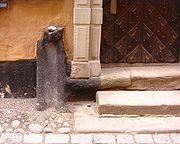
Västerlånggatan
Västerlånggatan is a street in Gamla stan, the old town of Stockholm, Sweden. Stretching southward between the squares Mynttorget and Järntorget, it follows the course of the city's now demolished 13th century defensive wall....
from around 1250-1300. During the later part of the 14th century, the streets started to get paved in stone, and as the archaeological deposits above them are composed of thin layers of filth containing few findings, street cleansing was apparently improved during this era. Waste and garbage was often simply poured out into the alleys, occasionally through apertures used exclusively for the purpose. Though a few assumed medieval subterranean wooden tubes and vaulted underground chambers have been found, relatively few traces remain in Stockholm of the sort of sophisticated system of sewers found in for example Visby
Visby
-See also:* Battle of Visby* Gotland University College* List of governors of Gotland County-External links:* - Visby*...
and Bergen
Bergen
Bergen is the second largest city in Norway with a population of as of , . Bergen is the administrative centre of Hordaland county. Greater Bergen or Bergen Metropolitan Area as defined by Statistics Norway, has a population of as of , ....
, so most likely the sloping alleys simply had to do the job. Many public notices were in vain devoted to restrain the habit of littering the surrounding waters and restricting the number of animals kept within the city walls, and not until the end of the Middle Ages were gutter
Gutter
panels of a comic strip or comic book page*Gutter , the space between panes of postage stamps that creates configurations of "gutter pairs" or "gutter blocks"*Gutter, in interface design, the blank spaces that separate rows and columns in screen...
s ordered to be cleaned twice a week and the placement of bogs forbidden next to neighbours and thoroughfares. Latrines were gathered on central locations known as flugmöten ("fly meetings") where the number of insects darkened the sky well into the 19th century.
The present alleys only give a vague glimpse of the appearance of the medieval city where the gables of the building were facing the streets and contained window bays for offering goods of sale; where filth, the bumpy paving and hand-drawn vehicles made walking circumstantial; and where odours and scents from dung, food, fishes, leather, furnaces, and seasonal spices mingled. During nights (and certainly during the long winters) the city was completely dark, save for exceptional fire watchers and nocturnal ramblers who used torches to find their bearing. Neither were there any street signs guiding foreigners as no streets were officially named, instead referred to as "the thoroughfare running from the outer southern gate and up to the cross and the chapel" or constantly renamed after the most prominent person settled in an exposed part of the alley. Indeed, historical records contain many examples of obscure references to locations in the city, close to impossible to pin down as some streets have been renamed dozens of times, often carrying the same or a similar name as other streets before physically ceasing to exist.
17th century
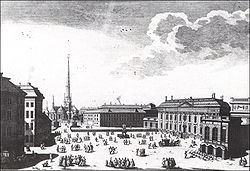
History of Sweden
Modern Sweden started out of the Kalmar Union formed in 1397 and by the unification of the country by King Gustav Vasa in the 16th century. In the 17th century Sweden expanded its territories to form the Swedish empire. Most of these conquered territories had to be given up during the 18th century...
, the first half of the 17th century was a period of awakening which preceded the so called Swedish Empire
Swedish Empire
The Swedish Empire refers to the Kingdom of Sweden between 1561 and 1721 . During this time, Sweden was one of the great European powers. In Swedish, the period is called Stormaktstiden, literally meaning "the Great Power Era"...
. Following the death of Gustavus II Adolphus
Gustavus Adolphus of Sweden
Gustav II Adolf has been widely known in English by his Latinized name Gustavus Adolphus Magnus and variously in historical writings also as Gustavus, or Gustavus the Great, or Gustav Adolph the Great,...
(1594–1632) the nation was determined never having to repeat the embarrassment experienced when Stockholm, still medieval in character, caused hesitation on whether to invite foreign statesmen for fear the lamentable appearance might undermine the nation's authority.
A map of Stadsholmen dated 1626 presents a proposal for two streets roughly equivalent to the southern stretches of today's Tyska Brinken
Tyska Brinken
Tyska Brinken is a street in Gamla stan, the old town in central Stockholm, Sweden. Extending Kindstugatan passed the German Church down to the square Mälartorget, it is crossed by Skomakargatan, Prästgatan, Västerlånggatan, Stora Nygatan, Lilla Nygatan, and Munkbrogatan, while forming a parallel...
and Stora Nygatan
Stora Nygatan
Stora Nygatan is a street in Gamla stan, the old town in central Stockholm, Sweden.Old names : nyegatun , nyia gaatan, den nya Konnungsgatun, stora konungsgatun , den store Nye gatan , Konnungsgatun , Nye gaten, KongsGaten , Kongs- eller stoora Nygatan, stora Kongs- el' Nygatan , Stora...
. Within short, however, it was realized the proposal would produce the northern end of the boulevard
Boulevard
A Boulevard is type of road, usually a wide, multi-lane arterial thoroughfare, divided with a median down the centre, and roadways along each side designed as slow travel and parking lanes and for bicycle and pedestrian usage, often with an above-average quality of landscaping and scenery...
-like street would be pointing at a non-notable medieval façade, and it what thus decided the street had to be lengthened all the way to the northern shore of the island — a project that would take decades to complete. The two straight streets Stora Nygatan
Stora Nygatan
Stora Nygatan is a street in Gamla stan, the old town in central Stockholm, Sweden.Old names : nyegatun , nyia gaatan, den nya Konnungsgatun, stora konungsgatun , den store Nye gatan , Konnungsgatun , Nye gaten, KongsGaten , Kongs- eller stoora Nygatan, stora Kongs- el' Nygatan , Stora...
and Lilla Nygatan
Lilla Nygatan
Lilla Nygatan is a street in Gamla stan, the old town of Stockholm, Sweden. Stretching from the square Munkbron south to Kornhamnstorg, the street in intercepted by Yxsmedsgränd, Kåkbrinken, Schönfeldts Gränd, Tyska Brinken, and Lejonstedts Gränd, while forming a parallel street to Stora Nygatan...
("Large/Small New Street") — both children of this second regulation — took a time long to realize and were not completed until the funeral of King Charles X in 1660. Soon this ambitious project led to a more representative framework. The informal northern end of Stora Nygatan was thus connected to the newly created square Mynttorget
Mynttorget
Mynttorget is a public square in Gamla stan, the old town in central Stockholm, Sweden.- Setting :From the square the bridge Stallbron leads over to the Parliament island Helgeandsholmen; to the west the street Myntgatan leads to Riddarhustorget, while the quay Kanslikajen stretches along the...
by Myntgatan
Myntgatan
Myntgatan is a street in Gamla stan, the old town in central Stockholm, Sweden. Stretching west from Mynttorget over to Riddarhustorget, it is crossed by the streets Salviigränd, Rådhusgränd, Riddarhusgränd, and Storkyrkobrinken....
, and the slope Storkyrkobrinken
Storkyrkobrinken
Storkyrkobrinken is a street in Gamla stan, the old town in central Stockholm, Sweden.Leading from Högvaktsterrassen near the Royal Palace down to Myntgatan and Riddarhustorget it forms a parallel street to Salviigränd and Stora Gråmunkegränd and is crossed by Trångsund, Prästgatan, and...
was widened.
On the eastern side of the island, the obsolete medieval wall was gradually demolished, and before the end of the century completely replaced by a row of private palaces, the so called Skeppsbroraden, the "Row of Skeppsbron
Skeppsbron
Skeppsbron is both a street and a quay in Gamla stan, the old town of Stockholm, capital of Sweden, stretching from the bridge Strömbron in front of the Royal Palace southward to Slussen....
". To what extent these two projects were planned and initiated by the King Gustavus II Adolphus
Gustavus Adolphus of Sweden
Gustav II Adolf has been widely known in English by his Latinized name Gustavus Adolphus Magnus and variously in historical writings also as Gustavus, or Gustavus the Great, or Gustav Adolph the Great,...
himself remains undocumented, but undoubtedly he must have played an important role. These projects were, nevertheless, accompanied by similar ambitions for Riddarholmen
Riddarholmen
Riddarholmen is a small islet in central Stockholm, Sweden. The island forms part of Gamla Stan, the old town, and houses a number of private palaces dating from the 17th century...
, where eventually several new palaces would be built, and for the ridges surrounding the city, where Chancellor Axel Oxenstierna
Axel Oxenstierna
Axel Gustafsson Oxenstierna af Södermöre , Count of Södermöre, was a Swedish statesman. He became a member of the Swedish Privy Council in 1609 and served as Lord High Chancellor of Sweden from 1612 until his death. He was a confidant of first Gustavus Adolphus and then Queen Christina.Oxenstierna...
had the medieval slum replaced by a more representative Baroque
Baroque architecture
Baroque architecture is a term used to describe the building style of the Baroque era, begun in late sixteenth century Italy, that took the Roman vocabulary of Renaissance architecture and used it in a new rhetorical and theatrical fashion, often to express the triumph of the Catholic Church and...
city.
See also
- History of StockholmHistory of StockholmThe history of Stockholm, capital of Sweden, for many centuries coincided with the development of what is today known as Gamla stan, the Stockholm Old Town...
- List of streets and squares in Gamla stan

